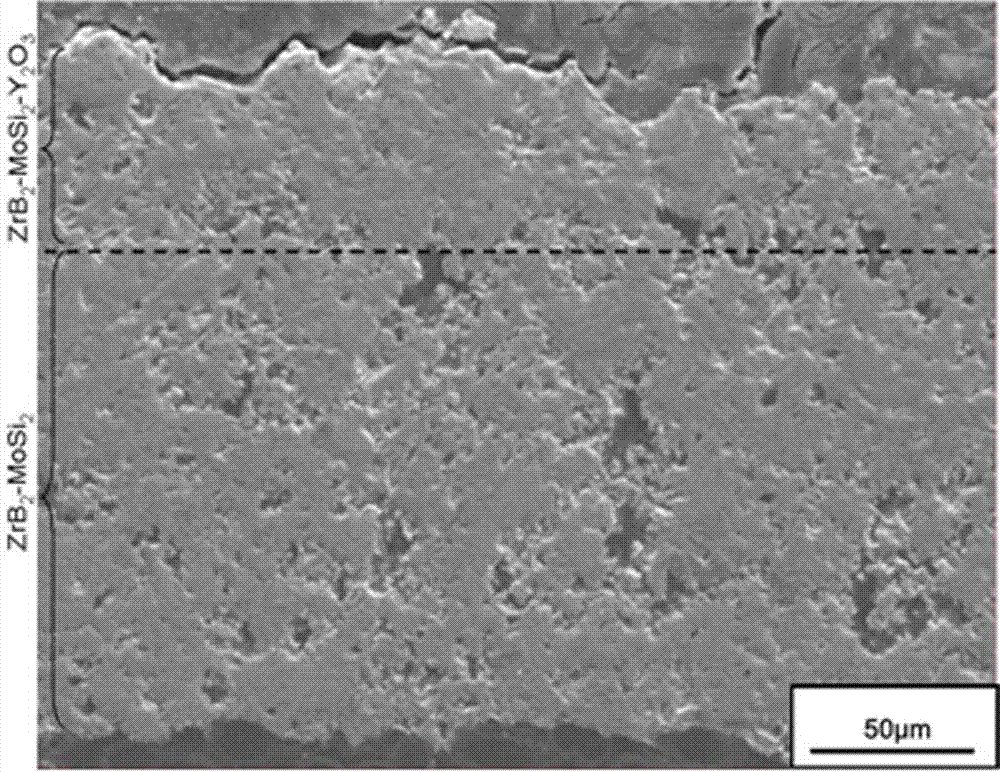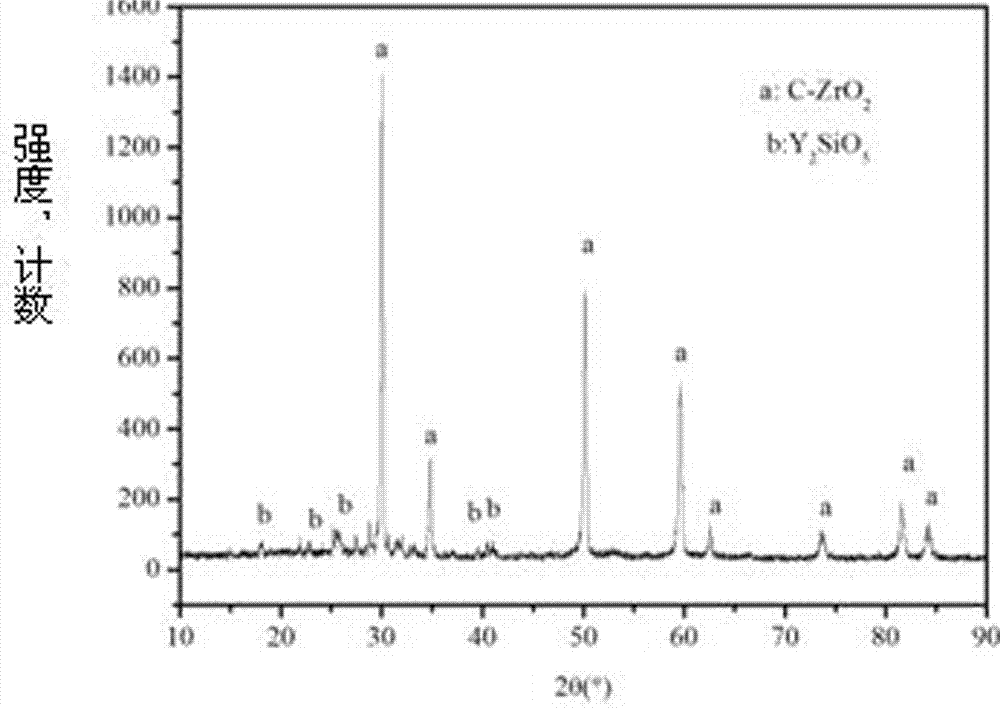Method for preparing ablation-resistant coating
An anti-ablation and coating technology is applied in the field of preparation of anti-ablation coatings, which can solve the problems of high cost, ablation of C/C composite materials, and poor coating quality, and achieves improved fluidity and high temperature resistance. The effect of ablative properties
- Summary
- Abstract
- Description
- Claims
- Application Information
AI Technical Summary
Problems solved by technology
Method used
Image
Examples
Embodiment 1
[0026] (1) Ingredients ball milling: Mix zirconium diboride, molybdenum disilicide and yttrium oxide with a particle size of 1~3μm in a mass ratio of 65:30:5, and then mix the mixed powder and adhesive in a mass ratio of 95:5 Mix, add deionized water with 1.5 times the mass of the mixture, and ball mill for 24 hours to form a slurry;
[0027] (2) Spray drying: The slurry in step (1) is atomized and dried in a spray drying tower, the outlet temperature of the drying tower is about 110°C, and the slurry is stirred with a mixer to make a spherical powder;
[0028] (3) Sintering: put the spherical powder in step (2) in a vacuum resistance furnace, sinter at 1200°C, keep it warm for 1 hour, and cool down with the furnace after sintering;
[0029] (4) Screening: pass the spherical powder sintered in step (3) through a 325-mesh sieve to obtain zirconium diboride-molybdenum disilicide-yttrium oxide powder for spraying, whose appearance is as follows figure 1 As shown in the scanning ...
Embodiment 2
[0035] (1) Ingredients ball milling: Mix zirconium diboride, silicon silicide and yttrium oxide with a particle size of 1~3μm at a mass ratio of 55:35:10, and then mix the mixed powder and adhesive at a mass ratio of 96:4 , add deionized water 1.5 times the mass of the mixture, and ball mill for 32 hours to form a slurry;
[0036] (2) Spray drying: The slurry in step (1) is atomized and dried in the spray drying tower, the outlet temperature of the drying tower is about 130°C, and the slurry is stirred with a mixer to make spherical powder;
[0037] (3) Sintering: put the spherical powder in step (2) in a vacuum resistance furnace, sinter at 1600°C, keep it warm for 2 hours, and cool down with the furnace after sintering;
[0038] (4) Sieving: pass the spherical powder sintered in step (3) through a 325 mesh sieve to obtain zirconium diboride-silicon carbide-yttrium oxide powder for spraying;
[0039] (5) Coating preparation: Plasma spraying equipment is used, the spraying pr...
Embodiment 3
[0042] (1) Ingredients ball milling: Mix zirconium diboride, molybdenum disilicide and yttrium oxide with a particle size of 1~3μm at a mass ratio of 56:36:8, and then mix the mixed powder and adhesive at a mass ratio of 95:5 Mix, add deionized water with 1.5 times the mass of the mixture, and ball mill for 24 hours to form a slurry;
[0043] (2) Spray drying: The slurry in step (1) is atomized and dried in a spray drying tower, the outlet temperature of the drying tower is about 110°C, and the slurry is stirred with a mixer to make a spherical powder;
[0044] (3) Sintering: put the spherical powder in step (2) in a vacuum resistance furnace, sinter at 1200°C, keep it warm for 1 hour, and cool down with the furnace after sintering;
[0045] (4) Sieving: passing the sintered spherical powder in step (3) through a 325-mesh sieve to obtain zirconium diboride-molybdenum disilicide-yttrium oxide powder for spraying;
[0046] (5) Coating preparation: Plasma spraying equipment is u...
PUM
| Property | Measurement | Unit |
|---|---|---|
| Particle size | aaaaa | aaaaa |
| Fluidity | aaaaa | aaaaa |
| Bulk density | aaaaa | aaaaa |
Abstract
Description
Claims
Application Information
 Login to View More
Login to View More - R&D
- Intellectual Property
- Life Sciences
- Materials
- Tech Scout
- Unparalleled Data Quality
- Higher Quality Content
- 60% Fewer Hallucinations
Browse by: Latest US Patents, China's latest patents, Technical Efficacy Thesaurus, Application Domain, Technology Topic, Popular Technical Reports.
© 2025 PatSnap. All rights reserved.Legal|Privacy policy|Modern Slavery Act Transparency Statement|Sitemap|About US| Contact US: help@patsnap.com



